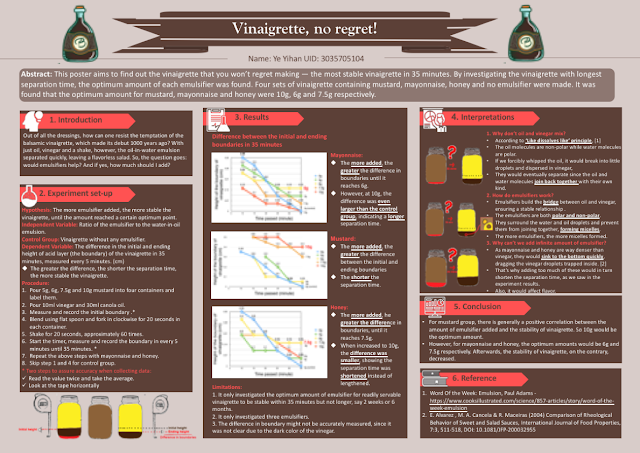How different types of emulsifier and stabilizer affect the stability of the vinaigrette
How different types of emulsifier and stabilizer affect the stability of the vinaigrette
(Source: https://www.loamagronomics.com/2019/02/22/frisee-salad-with-bacon-and-pickled-grape-vinaigrette/)
Introduction:
Vinaigrette is a common salad dressing originated in France. It is a mixture of two main ingredients: oil and vinegar. However, vinegar is water-based, making it not mix with oil even if we beat it thoroughly. Therefore, many choose to add a kind of emulsifier into the vinaigrette to allow the two ingredients to mix instead of mixing them every time they use it. There exist countless websites and articles about emulsifiers. However, different websites give different examples or even contradict each other, causing confusion. The aim of this project is to find out which ingredient mentioned in the websites truly have an emulsifying effect and which one of them has the strongest effect.
Who?
What?
- 100 ml of Cooking Oil
Experimental Test
Who?
Chan Ka Man (UID: 3035574543)
What?
To explore different emulsifiers and find out if they have different effects.
Where?
At my home.
When?
Carry out the tests and measurements after making the vinaigrettes and putting them into their respective containers.
Why?
To find out which commonly-used emulsifier has the strongest emulsifying effect, or if they are even emulsifiers in the first place.
How?
Put equal amounts of oil and vinegar into 4 containers respectively. Add 3 different commonly-used emulsifiers (honey, cheese, egg yolk) into 3 of the containers respectively while leaving the last one as a control. Mix the vinaigrette. Measure the size of the oil droplets and check the clarity of the mixture immediately after mixing and 5, 30, 60 minutes afterward.
Ingredients and equipment needed:
- 100 ml of Cooking Oil
- 300 ml of Grape Vinegar
- 2.5 ml of Honey
- 2.5cm3 of Cheese
- 1 Egg yolk
- 4 glass containers with lid
- Measuring cup
- Measuring spoon
Controlled variables:
- Source/Brand of cooking oil
- Source/Brand of grape vinegar
- Size of glass containers
- Amount of emulsifier used
- Time of mixing
- Method of mixing
- Temperature of environment
Independent variable:
- Type of emulsifier used
Dependent variable:
- Clarity of the mixture and the size of the oil droplets over time (measure immediately and 5, 30, 60 minutes after mixing)
Science behind:
Oil and water are fundamentally different compounds. Water is a compound made of one oxygen atom and 2 hydrogen atoms. Since there are 2 lone pair electrons at the oxygen atom, the 2 hydrogen atoms are pushed away from the central axis, thus giving the compound a bent shape instead of a linear structure. Such structure and the 2 lone pair electrons, coupling with the dipole moment caused by differences in electronegativity which points from each hydrogen atom to the oxygen atom, make the oxygen atom partially negative and the 2 hydrogen atoms partially positive. This phenomenon makes the water molecule polar and thus can form hydrogen bonds with other polar molecules.
(Chemical structure of water. Source: https://en.wikipedia.org/wiki/Properties_of_water)
Meanwhile, oil compounds are made of a glycerol molecule (a chain of 3 carbon atoms) and 3 fatty acid molecules (a long chain of carbon atoms). Since carbon chains are not polar, there is only weak van der Waal's force between molecules, thus they cannot attract polar molecules, like water. Since vinegar is water-based, which means it is a solution dissolved in water, it is immiscible with oil, and the two will separate into 2 distinct layers after mixing.
(Chemical structure of a vegetable oil, namely rapeseed oil. Source: https://www.researchgate.net/figure/Molecular-structure-of-a-vegetable-oil-example-applies-for-rapeseed-oil-All-double_fig1_223370968)
Emulsifiers are compounds that have a hydrophilic head (soluble in and attracts water) and a hydrophobic tail (soluble in and attracts oil). When added into the oil and water mixture, and after mixing them together, the head of the emulsifier bonds with water while its tail bonds with oil. It then covers the surface of either oil or water droplets, preventing the two from separating. This creates the effect of emulsion, which means the water and oil molecules are miscible with each other.
(Chemical structure of a typical emulsifier. Source: https://www.sciencelearn.org.nz/images/1291-surfactants)
Reference:
Larsen, L. The Meaning of Emulsify in Cooking and Baking. The Spruce Eats. Retrieved from https://www.thespruceeats.com/what-does-emulsify-mean-480592.
Zelman, K. Food Additives: Emulsifiers. Food & Nutrition. Retrieved from https://foodandnutrition.org/november-december-2017/food-additives-emulsifiers/.






Comments
Post a Comment